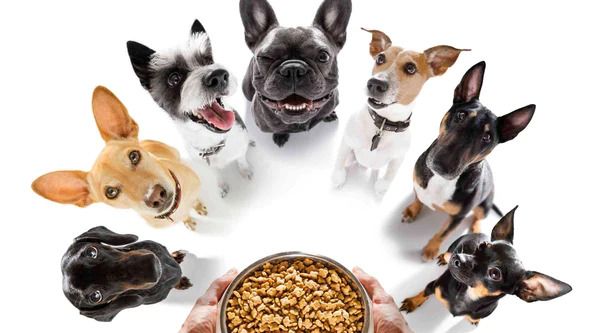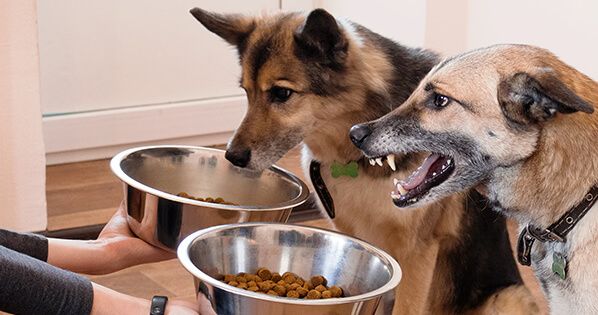Food aggression, a behavioral issue seen in both dogs and cats, can be a challenging problem for pet owners to manage. This article explores the causes, signs, and ways to address food aggression in your furry companions. Let's dive in.

Introduction
Food aggression, also known as resource guarding, is a behavioral problem where pets display aggressive behavior when they perceive a threat to their food or possessions. This aggression can manifest in various forms, such as growling, snapping, or even biting. Addressing food aggression is crucial for the safety of both pets and their owners.
Signs and Symptoms of Food Aggression
Food aggression, a potentially dangerous behavior in pets, manifests through various signs and symptoms. Identifying these warning signals is essential for ensuring the safety of both the pet and its owner. In this section, we will explore the common signs and symptoms associated with food aggression in dogs and cats.

1. Aggressive Behaviors During Mealtime
One of the most evident signs of food aggression is the display of aggressive behaviors during mealtime. These behaviors can include:
- Growling: The pet emits a low, threatening growl when approached while eating.
- Snapping: Sudden snapping or biting motions, often accompanied by bared teeth.
- Barking: Intense and aggressive barking aimed at deterring anyone from approaching the food.
- Guarding: The pet positions itself defensively around its food bowl or dish.
2. Body Language Cues
Understanding your pet's body language is crucial in detecting food aggression. Look for the following cues:
- Stiffening: The pet's body becomes tense and rigid, indicating heightened alertness.
- Raised Fur: The fur along the back or neck may stand on end, a clear sign of agitation.
- Intense Stare: The pet maintains an unwavering and fixated gaze on the food.
- Ears Back: Ears pinned back against the head suggest a defensive posture.
3. Identifying Food Aggression in Dogs and Cats
Food aggression is not limited to dogs; cats can also exhibit similar behaviors. In dogs, the signs are often more overt, while in cats, they may be subtler. Here's how to identify food aggression in both:
- Dogs: Besides the behaviors mentioned earlier, dogs may display body blocking, where they physically position themselves between their food and the perceived threat.
- Cats: Cats may exhibit avoidance behaviors, such as hissing, swatting, or retreating when approached during mealtime. They may also glare or flatten their ears.
Recognizing these signs early on is critical to addressing food aggression promptly. Ignoring these behaviors can lead to escalated aggression and pose a risk to the safety of both the pet and those around them.
In the following sections, we will delve deeper into the underlying causes of food aggression, shedding light on the psychological aspects and factors contributing to this concerning behavior.
Causes of Food Aggression
Food aggression in dogs is a complex behavioral issue that can stem from various underlying causes. Understanding these causes is crucial for effectively addressing and managing this potentially dangerous behavior. In this section, we will explore the primary factors that contribute to food aggression in dogs.
1. Evolutionary Factors
One of the fundamental causes of food aggression in dogs can be traced back to their evolutionary history. In the wild, canines are natural scavengers and opportunistic hunters. They have an innate drive to protect their resources, including food, as it is vital for their survival. This instinctual behavior, rooted in their DNA, can manifest as food aggression when domesticated dogs perceive a threat to their meal.
2. Learned Behavior
Food aggression can also develop as a learned behavior. Dogs that have experienced competition for food, either within a multi-pet household or during a period of scarcity, may develop aggressive tendencies as a means of securing their sustenance. Over time, this learned behavior can become deeply ingrained and challenging to modify.
3. Medical Causes
It's essential to consider potential medical causes when addressing food aggression in dogs. Discomfort or pain while eating can trigger defensive behaviors. Dental problems, gastrointestinal issues, or any underlying health conditions that cause pain or discomfort during mealtime can make a dog more prone to food aggression.
4. Environmental Stressors
Changes in the environment or routine can contribute significantly to food aggression in dogs. Situations such as the introduction of a new pet into the household, moving to a new location, or disruptions in their daily schedule can create stress and anxiety. Dogs may react by guarding their food more aggressively as a response to these environmental stressors.
5. Territorial Instincts
Dogs often perceive their feeding area as their territory. Food aggression can be an extension of their territorial instincts. They may feel the need to protect their "territory" and resources, including food, from perceived threats, whether real or imagined.
6. Resource Guarding
Resource guarding is a broader behavior that encompasses not only food but also other possessions like puzzle toys, bones, or even sleeping areas. Dogs exhibiting resource-guarding tendencies may become food-aggressive as part of their overall guarding behavior, aiming to protect their possessions from others.
Understanding the specific cause or combination of factors contributing to a dog's food aggression is crucial in developing an effective intervention plan. In the subsequent sections, we will delve deeper into the psychology behind food aggression and explore the impact it can have on both pets and their owners.
Understanding the Psychology Behind Food Aggression

Food aggression in dogs is not merely a surface-level behavior; it is rooted in complex psychological and instinctual factors. To effectively address and manage this challenging behavior, it is essential to delve into the psychology behind dog food aggression. In this section, we will explore the underlying psychological aspects that drive food aggression in dogs.
1. Territorial Instincts
One of the key psychological components of food aggression is the dog's territorial instincts. Dogs often view their feeding area as their territory, a safe haven where they consume their meals. This territoriality is deeply ingrained in their nature, dating back to their ancestors' survival instincts in the wild. When they perceive a threat to their territory, which includes their food, they may respond with aggression as a means of protecting it.
2. Resource Guarding
Food aggression can also be linked to the broader behavior of resource guarding. Dogs may not only guard their food but also other possessions like interactive dog toys, bones, or sleeping spots. This behavior is rooted in the dog's belief that these resources are valuable and must be protected. Resource guarding can extend to food, leading to food aggression as a manifestation of this guarding instinct.
3. Fear and Anxiety
Food aggression can sometimes be driven by fear and anxiety. Dogs may feel threatened or insecure during mealtime, leading to aggressive responses as a way to defend themselves. This fear can result from various factors, including past traumatic experiences, a lack of socialization, or underlying separation anxiety disorders. Understanding the role of fear and anxiety is crucial in addressing the emotional aspects of food aggression.
4. Past Experiences
A dog's past experiences can significantly shape its behavior, including food aggression. If a dog has encountered situations where it had to compete for food or faced food scarcity, it may develop aggressive tendencies as a survival strategy. These learned behaviors can persist into their domestic lives and become challenging to modify.
5. Social Dynamics
The social dynamics within a multi-pet household can also influence food aggression. Dogs may engage in competitive behaviors when sharing space with other pets during mealtime. Hierarchical disputes or perceived competition for limited resources can trigger food aggression in an attempt to establish dominance.
6. Training and Socialization
The absence of proper training and socialization during a dog's developmental stages can contribute to food aggression. Dogs that have not been exposed to various people, animals, and situations may lack the skills to navigate social interactions calmly, leading to heightened anxiety and defensive responses during mealtime.
Understanding the psychological factors at play in food aggression is a crucial step in developing a targeted intervention and management plan. In the following sections, we will explore ways to prevent and manage food aggression, ensuring the safety and well-being of both pets and their owners.
The Impact of Food Aggression on Pets and Owners
Food aggression in dogs can have far-reaching consequences that extend beyond mealtime. Understanding the impact of food aggression on both pets and owners is essential for appreciating the urgency of addressing this behavior.

Physical Harm
One of the most immediate concerns is the potential for physical harm. When a dog displays food aggression, it may resort to aggressive behaviors such as biting or snapping. This can result in injuries to other pets in the household, children, or even the dog's owner. These injuries can range from minor bites and scratches to more severe wounds requiring medical attention.
Emotional Stress
Food aggression can create an environment of emotional stress and anxiety within the household. Pets that exhibit food aggression often live in a constant state of alertness, fearing potential threats to their meals. This stress can negatively impact their overall well-being and may manifest in other behavioral issues.
Strained Owner-Pet Relationship
Food aggression can strain the relationship between owners and their pets. The fear of aggression during mealtime can lead to owners avoiding necessary interactions with their dogs, such as feeding, which can hinder the development of a strong bond. In severe cases, it can erode the trust and affection between pet and owner.
Addressing food aggression is not only about preventing physical harm but also about creating a harmonious and stress-free living environment for both pets and their human companions. In the following sections, we will explore methods for preventing and managing food aggression effectively.
Preventing Food Aggression
Preventing food aggression is a proactive approach to ensure a safe and harmonious mealtime environment for your dog. Here are some key strategies for prevention:
Early Socialization and Training
Start socializing and training your dog from a young age. Exposure to various people, animals, and situations during their critical developmental stages can help dogs become well-adjusted and less prone to anxiety and aggression.
Gradual Desensitization
Gradual desensitization involves exposing your dog to situations that trigger food aggression in a controlled and gradual manner. For example, gradually introduce other pets or family members during mealtime, rewarding calm behavior.
Consistent Feeding Routines
Establish and maintain a consistent feeding routine. Dogs thrive on routine, and knowing when to expect meals can reduce anxiety. Feeding at the same times each day can help create a sense of security.
Positive Reinforcement
Reinforce positive behaviors during mealtime. Use treats and praise to reward your dog for calm and non-aggressive behavior. Positive reinforcement can help your happy dog associate mealtime with positive experiences.
Managing Food Aggression
Managing food aggression in dogs is essential if it has already developed. Here are some effective strategies to manage this behavior:

Safety Precautions
Prioritize safety when managing a food-aggressive dog. Keep children and other pets away during mealtime to avoid potential conflicts. Use physical barriers like baby gates if needed.
Seeking Professional Help
Consult with a professional dog trainer or a veterinary behaviorist who specializes in aggression issues. They can assess your dog's behavior and provide a tailored intervention plan.
Medication Options
In severe cases of food aggression where underlying anxiety or fear is a significant factor, medication prescribed by a veterinarian may be considered. These medications can help reduce anxiety and make behavior modification more effective.
Behavior Modification Techniques
Work with a professional to implement behavior modification techniques that address the specific triggers and responses of your dog's food aggression. This may involve desensitization exercises, counterconditioning, and structured training.
Successfully managing food aggression requires commitment, patience, and consistency. It's important to remember that progress may be gradual, and professional guidance is often invaluable in achieving the best outcomes.
Case Studies
Let's explore real-life cases where food aggression was successfully managed through interventions and training techniques. These stories serve as inspiring examples of positive outcomes.
Tips for Dealing with Food Aggressive Pets
- Dos and Don'ts for Owners: Offer guidance on how to react when encountering food aggression.
- Creating a Safe Feeding Environment: Share tips on setting up a secure feeding space.
- Building Trust with Your Pet: Provide insights into nurturing a strong bond with your pet.
Conclusion
In conclusion, food aggression is a complex issue that can pose risks to pets and their owners. Understanding its causes and implementing preventive measures is crucial. Seek professional guidance when dealing with severe cases, and remember that with patience and the right approach, food aggression can be managed effectively.
FAQs
Q1: What breeds are more prone to food aggression?
- Food aggression can occur in any breed, but it may be more common in those with guarding or protective instincts, such as Rottweilers or Australian Cattle Dogs.
Q2: Is food aggression more common in dogs or cats?
- It can occur in both dogs and cats, but it's often more associated with dogs. Cats may also display resource guarding behaviors, but they are generally less aggressive about it.
Q3: Can food aggression be cured completely?
- While complete cure is not guaranteed, food aggression can be managed and significantly improved with the right training and interventions.
Q4: Should I ever attempt to take food away from an aggressive pet?
- No, attempting to take food from an aggressive pet can be dangerous. Always seek professional advice and use caution when dealing with a food-aggressive animal.
Q5: Are there any home remedies for food aggression?
- Home remedies may not be sufficient for severe cases of food aggression. It's best to consult with a veterinarian or animal behaviorist for a tailored approach.
In this comprehensive guide, you've learned about food aggression in pets, its causes, and how to address it effectively. Remember that patience, training, and professional guidance can make a significant difference in managing this challenging behavior. Keep your pet's safety and well-being a top priority.




